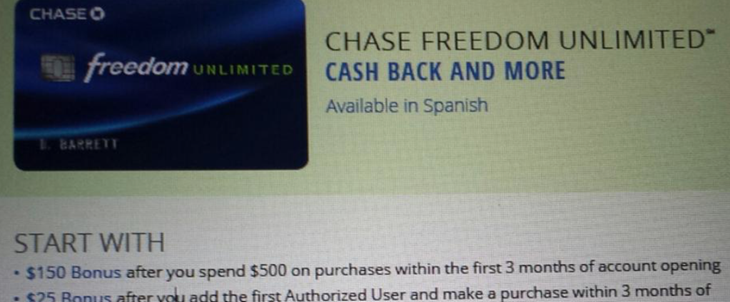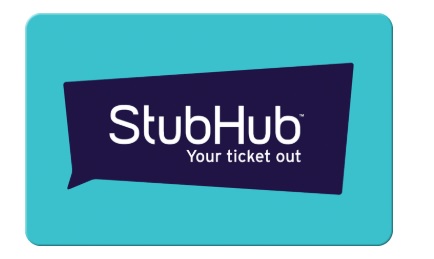NOTICE: This post references card features that have changed, expired, or are not currently available
UPDATE: The Points Guy has learned more from Chase. All of the assumptions in this post appear to be true! Chase Freedom Unlimited will coexist with the original Freedom card; It will have no annual fee; and it will earn Ultimate Rewards points.
Over the weekend, Angelina Travels revealed what appears to be a new credit card from Chase: Chase Freedom Unlimited. Supposedly this new card will be introduced sometime in March (i.e. soon!).
Click through to Angelina’s post to see the full image and card details.
Here are the basic details:
- $150 signup bonus (after you spend $500 in 3 months). Get an additional $25 for adding an authorized user.
- Earn 1.5% cash back everywhere. Unlike the standard Freedom card, there are no 5% bonus categories
- I assume that this card has no annual fee (it doesn’t say so in the image, but I don’t think that Chase can compete in the 1.5% cash back market if they charge an annual fee)
I believe that Chase Freedom Unlimited is an additional Freedom card, not a replacement
Angelina states that this new card will replace the current Freedom card (which offers rotating 5% categories and 1% on all other spend). I will be very surprised if that is true. The fact that Chase gave this card a new name, Freedom Unlimited, suggests to me that they think of it as a separate product. Chase used to offer both a Sapphire card and a Sapphire Preferred card at the same time. I think that this is similar. True, they may phase out the basic Freedom card over time (as they did with the Sapphire card), but I doubt that it will go away soon.
MileCards posted a slide from JP Morgan Chase Investor Day that supports my belief. They showed that Chase is now referring to Freedom as a portfolio rather than a card:
Click through to MileCards’ post to the full image and details.
The only reason I can think of that Chase would refer to Freedom as a “portfolio” is if there were multiple different cards with the Freedom name.
This is awesome for mile/point collectors if the card earns Ultimate Rewards points
The Chase Ink Cash card and the current Chase Freedom card are marketed as cash back cards. In reality, they earn Ultimate Rewards points which can be converted easily to cash. Even better, points can be made more valuable by moving them to a Sapphire Preferred or Ink Plus account. This way, points can then be used for 1.25 cents per point towards travel or, better yet, transferred to partner loyalty programs in which points are often worth more than 1.25 cents each. These include Hyatt, United, Southwest, etc.
We don’t yet know if the Freedom Unlimited card earns Ultimate Rewards points, but I think it’s likely that it does. If so, then suddenly Chase has a strong contender for your “everywhere else” spend.
As I described in my post “Best credit card combos: Ultimate Rewards,” it is currently possible to average 2 Ultimate Rewards points per dollar, or more, by mixing and matching Chase Ultimate Rewards cards:
- Use the old Freedom card for all spend within its quarterly 5X categories (up to $1500 per quarter). The specific categories change each year. This year they’re offering 5X for gas stations in quarter 1; 5X for grocery stores in quarter 2; 5X for restaurants and more in quarter 3; and 5X for holiday shopping in quarter 4.
- Use the Chase Ink Cash or Ink Plus for all spend within its 5X categories: office supply stores, cellular, landline, and cable. Also use the Chase Ink card for 2X gas.
- Use the Sapphire Preferred card for 2X travel and dining.
- Use any of the cards for all other spend. They all offer only 1 point per dollar for “everywhere else” spend.
Given assumptions about how much a person might spend within each category, I calculated that a person might average 2.16 points per dollar by following the above rules.
Now, with the Freedom Unlimited card, there’s a great option for that “everywhere else” spend: with the Freedom Unlimited you’ll earn 1.5 points per dollar. In my Credit Card Analysis Spreadsheet I modeled the addition of this card to the mix shown above. With this card added in, a person with my assumed mix of spend would earn 2.36 points per dollar.
Rationally, an additional 0.2 points per dollar is hardly worth getting excited about. But, if you spend more in the “all other” category than I estimated (about 20%), then it could be huge.
Note that the above scenario assumes that a person wants to go “all in” with Chase Ultimate Rewards. If you’re interested in seeing ways to mix and match various cards, please see: Best credit card combos: Mixed rewards. Or, if you prefer cash back, see: Best credit card combos: Cash Back.
Freedom Unlimited vs. other everyday spend cards
In my post “Best rewards for everyday spend” I list a number of cards that offer rewards worth 2% cash back or better on all spend. While there are several cards that offer better than 2% cash back rewards, each has tough requirements or strict limits (e.g. the Discover It Miles card earns 3% cash back, but just for the first year. After that it earns only 1.5%). The benchmark for everyday cards comes from the no fee 2% cash back cards offered by Citi and Fidelity.
If you’re only interested in cash back then the Freedom Unlimited is obviously inferior to the 2% cash back cards. In fact, it may be inferior to many 1.5% cash back cards since some of them offer additional perks that the Freedom Unlimited card might not (for example, the Discover It Miles card offers $30 of free in-flight wifi per year). However, the equation is completely different if you’re interested in the card’s Ultimate Rewards program (assuming it earns Ultimate Rewards!) for the ability to transfer points to airline and hotel programs (when transferred first to the Sapphire Preferred or Ink Plus card).
Using the Freedom Unlimited card for everyday purchases instead of a 2% cash back card is like buying Ultimate Rewards points for 1.33 cents each. Whether or not that’s a good deal depends upon how you would use those points and whether or not you have ways of “buying” Ultimate Rewards points for less. I’ll leave that mental exercise to the reader.
Freedom Unlimited vs. Everyday Preferred
There is only one other transferable points card that offers 1.5X points per dollar. That is the Amex EveryDay Preferred card (see: Amex’s powerful new EveryDay cards). The EveryDay Preferred card offers 3X points at US supermarkets on up to $6,000 per year in purchases (then 1x); 2X points at US gas stations; and 1X points on other purchases. What makes the card really powerful that it offers a 50% bonus when you use the card 30 or more times per billing cycle. With the 50% bonus, the card’s earning rate increases to: 4.5X points at US supermarkets on up to $6,000 per year in purchases (then 1.5x); 3X points at US gas stations; and 1.5X points on other purchases.
The EveryDay Preferred card does have a $95 annual fee, but since the Freedom Unlimited will most likely require the Sapphire Preferred or Ink Plus card, each also with a $95 annual fee, in order to transfer points to hotel and airline programs, I’d call the annual fee a wash.
If Ultimate Rewards and Membership Rewards points were equal, then I’d say that the EveryDay Preferred card may be better than the Freedom Unlimited thanks to its terrific bonus categories. That said, I’d argue that Ultimate Rewards is a better program for most people (see: Membership Rewards vs. Ultimate Rewards vs. ThankYou Rewards. Which is best?). Plus, the need to make 30 purchases a month with the EveryDay Preferred card in order to get the 50% bonus is a burden that most people would happily do without. Personally, I’d rather have the Freedom Unlimited card.
Conclusion
In this post I’ve made a number of assumptions about the new Freedom Unlimited card:
- It will coexist with the original Freedom card
- It will have no annual fee
- It will earn Ultimate Rewards points
If my assumptions prove true, this will be an excellent addition to the Ultimate Rewards family of products for those who prefer earning transferable points. Those who prefer earning cash back should look elsewhere.
UPDATE: My assumptions have been confirmed.







[…] Chase Freedom Unlimited (New): Earns 1.5 Ultimate Rewards points per dollar for all spend. Pair with a premium card (e.g. Sapphire Preferred, Ink Plus) to transfer points to several airline or hotel programs. This card is now available to sign-up over the phone or to product change from another Chase card. […]
I went to a Chase branch today and successfully phone in an application. The Unlimited will nicely compliment my Sapphire and Freedom!
Is it possible to convert an ink to a freedom?
From what I’ve read you can’t. But take that with a grain of salt as I’ve never personally attempted to downgrade a Chase cc from business to personal.
I don’t think it is possible to convert a Chase business card to a personal card.
Best overall analysis of this card across the blogosphere. If the 5% Freedom remains long term (more than a year) then this is a net-positive for everyone. One of the few we’ve had in 2016.
Thanks!
What I’m wondering is how soon will they offer a promotion on top of the base sign up of $150. Chase freedom regularly doubles their $100 base to $200 sign up bonus. So how soon after release do you think they will do a similar promo and raise it to say $300?
Do you foresee that happening at all this year?
I don’t know. In the past the Freedom was usually at 10K and then would go up to 20K as a promo. Now at 15K I don’t know what the pattern is, if any.
[…] Frequent Miler has an interesting take. Chase has begun using certain language related to the Freedom card that leads him to believe the bank may keep multiple, different, Freedom cards. […]
[…] Miler has a good analysis based on mostly correct assumptions about how this card stacks up against the competition. It is […]
TPG just posted about this and it seems that all of your assumptions are correct.
Thanks! I added an update to the top and bottom of the post.
Intriguing post…. would be sad if classic Chase Freedom w/ the 5% rotating categories ended.
BTW, re. “sometime in March,” has any clarity emerged on just when the new 5/24 restrictions will kick in regarding Chase INK business applications? (and about the “5” part — is it >5 or =5? (greater than or exactly 5) Happens spouse has exactly five new cards over past 24 months…. and thus the question.
1. No, I haven’t heard any more details about “sometime in March”
2. 5 / 24 rule = 5 or more within 24 months. BUT, the rule isn’t set in stone. Many people with 5 or more have been approved. My guess is that 5 is better than 6.